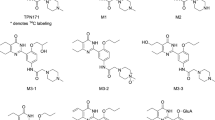Summary
ZK 36 374, a chemically stable and equipotent prostacyclin analogue, was tritium labelled at position 11 and administered orally or intravenously to rats in doses of 3–200 μg/kg. Excretion of radioactivity via urine, faeces and bile was studied in male and female animals. Enterohepatic recirculation was assessed by bile duct cannulation and by intraduodenal administration of radioactive bile samples. Metabolic patterns were determined by HPLC separation.
Most of the ZK 36 374 was metabolized in the rat and mainly excreted renally (60% of dose) in the form of 12 metabolites. Half-lives of renal and biliary elimination were 0.7–0.8 h in the α-phase. About 60% of the amount excreted via the bile was reabsorbed in the gut. Radioactivity in the urine collected on days 3, 5 and 7 was higher by one order of magnitude than on the preceding days 2, 4 and 6. Variations in the volume of urine as compared to a control group and different clearance rates of metabolites could be excluded as possible explanations for this effect, which still remains to be clarified.
Similar content being viewed by others
References
Dusting GJ., Moncada S. and Vane JR. (1977): Prostacyclin (PGX) is the endogenous metabolite responsible for relaxation of coronary arteries induced by arachidonic acid. Prostaglandins13, 3–16.
Moncada S., Gryglewski RJ., Bunting S. and Vane JR. (1976): A lipid peroxide inhibits the enzyme in blood vessel microsomes that generates from prostaglandin endoperoxides the substance (prostaglandin X) which prevents platelet aggregation. Prostaglandins12, 715–736.
Johnson RA., Morton DR., Kinner JH., Gorman RR., McGuire JC., Sun FF., Whittaker N., Bunting S., Salmon J., Moncada S., Higgs EA. and Vane J. (1976): The chemical structure of prostaglandin X (prostacyclin). Prostaglandins12, 915–928.
Moncada S., Higgs, EA. and Vane JR. (1977): Human arterial and venous tissues generate prostacylin (prostaglandin X) a potent inhibitor of platelet aggregation. Lancet1, 18–20.
Dusting GJ, Moncada S. and Vane JR., (1978): Disappearance of prostacyclin (PGI2) in the circulation of the dog. Brit J. Pharmacol 62 (3), 414P-415P.
Wong PYK., Sun FF. and McGiff JC. (1978): Metabolism of prostacyclin in blood vessels. J. Biol. Chem. 253 (16): 5555–5557.
Sun FF. and Taylor BM. (1978): Metabolism of prostacylin in rat. Biochemistry17, 4096–4099.
Wong PYK., McGiff JC, Cagen L., Malik KU. and Sun FF. (1979): Metabolism of prostacylin in the rabbit kidney. J. Biol. Chem. 254 (1), 12–14.
Wong PYK., McGiff JC, Sun FF. and Malik KU (1978): Pulmonary metabolism of prostacyclin (PGI2) in the rabbit. Biochem Biophys Res Commun 83 (2), 731–738.
Whittle BJR., Moncada S., Whiting F. and Vane JR. (1980): Carbacyclin — potent stable prostacyclin analogue for the inhibition of platelet aggregation. Prostaglandins19, 605–627.
Haberey M., Maass B., Mannesmann G., Skuballa W., Town M.-H. and Vorbrüggen H. (1980): Cardiovascular properties of ZK 36 374, a novel, stable prostacyclin derivative. Therapiewoche 30, 7860–7863.
Rumpf KW., Eisenhauer Th., Lange H., Schenk H.-D., Hilfiker O., Radke A. and Scheler F. (1980): Wirkungen eines stabilen Prostacyclinderivates auf Nieren- und Kreislauffunktion beim Hund. Therapiewoche30, 7887.
Casals-Stenzel J., Haberey H., Loge O., Losert WF., Mannesmann G., Radüchel B., Schillinger E., Skuballa W., Town M.-H., Vorbrüggen H. (1980): Pharmacology of a new potent and stable prostacyclin analogue, ZK 36 374. Acta Therap (Brusses) 6, Suppl. 37.
Hansson C. (1979): Metabolism of two PFG2a analogues in primates: 15(S)-15-methyl-Δ4-cis-PGF1α and 16,16-dimethyl-Δ4-cis-PGF1α. Prostaglandins18, 745–771.
Pace-Asciak CR., Rosenthal A. and Domazet Z. (1979): Comparison between the in vivo rate of metabolism of prostaglandin F 2 and its blood-pressure-lowering response after intravenous administration in the rat. Biochim Biophys Acta574, 182–186.
Taylor BM. and Sun FF. (1980): Tissue distribution and biliary excretion of prostacyclin metabolites in the rat. J. Pharm. Ther.214, 24–30.
Schillinger E., in preparation.
Author information
Authors and Affiliations
Rights and permissions
About this article
Cite this article
Krause, W., Skuballa, W. & Schulze, P.E. Pharmacokinetics and biotransformation of the prostacyclin analogue, ZK 36 374 I. Synthesis of a tritium marker and excretion of [3H]-ZK 36 374 in the rat. European Journal of Drug Metabolism and Pharmacokinetics 8, 137–144 (1983). https://doi.org/10.1007/BF03188739
Received:
Issue Date:
DOI: https://doi.org/10.1007/BF03188739




